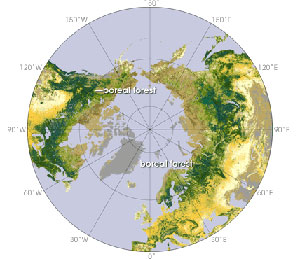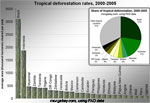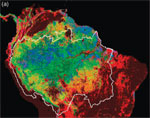Canada’s boreal forest must be saved
Canada’s boreal forest must be saved
Ecosystem stores 27 years of CO2 emissions
mongabay.com
May 14, 2007
At a conference Monday, 1500 prominent scientists called for protection of Canada’s boreal forest, one of the largest intact forest and wetland ecosystems remaining on the planet.
“The extraordinary level of support expressed in this letter demonstrates the global ecological importance of Canada’s Boreal Forest and the urgent need for Canada to protect it,” said David Schindler, Killam Memorial Chair and Professor of Ecology at the University of Alberta, Edmonton. “We are losing so many of the world’s great forests, despite the best efforts of conservationists. Canada’s Boreal Forest offers what may be our last, best chance to do things right, but only if our leaders act decisively and act now.”
The scientists said the forest is a major source of North America’s fresh water and home to some of the continent’s largest populations of wildlife, including wolves, grizzly bear and woodland caribou. They noted that the boreal forest is the world’s single-largest terrestrial reservoir of carbon, storing about 186 billion metric tons of carbon, equivalent to 27 years of the world’s carbon dioxide emissions from the burning of fossil fuels.
 The boreal forests (also called taiga) encircle the Arctic, occupying the northern expanses of Asia, Europe, and North America. In this map, the boreal forests are dark green areas, tundra and barren land are tan, while crops and grasslands are yellow. In total, the boreal forest covers 16.6 million square kilometers (6.41 million square miles.) (Map by Robert Simmon, based on data provided by BU Land Cover and Land Cover Dynamics.) |
“The Boreal Forest stores large quantities of carbon and provides a shield against global warming and critical habitat for countless species of birds, fish and wildlife,” said Dr. Terry Root, Stanford University Professor and author of several reports as a member of the Intergovernmental Panel on Climate Change (IPCC). “The world’s scientists urge Canada to take action now by implementing the Boreal Forest Conservation Framework.”
The framework calls for preserving at least half of Canada’s Boreal Forest in protected areas while allowing only carefully managed development on the remaining land. To date about 10 percent of the boreal forest has been protected and the ecosystem is under increasing pressure from logging, mining and oil and gas operations.
“Scientists recognize the urgent need to protect large parts of Canada’s Boreal,” said Larry Innes, Canadian Boreal Initiative’s Executive Director. “We owe it to our children to strike the right balance between conservation and development — and immediate action will be vital if we hope to protect this globally important ecosystem.”
“A generation ago scientists sounded the alarm about global warming, but we didn’t listen. Let’s not make that mistake again,” said Steve Kallick, director of The Pew Charitable Trusts’ International Boreal Conservation Campaign (IBCC). “Canada’s Boreal is a critical part of earth’s life support system. Scientists are warning us not to pull the plug.”
Learn more: Canadian Boreal Initiative
Related
Reducing tropical deforestation will help fight global warming

|
(05/09/2007) More scientists have joined the growing chorus to support a plan by developing countries to fight global warming by reducing deforestation rates. Tropical deforestation releases more than 1.5 billion metric tons of carbon into the atmosphere every year, though in some years, like the 1997-1998 el Niño year when fires released some 2 billion tons of carbon from peat swamps alone in Indonesia, emissions are more than twice that. Writing in the journal Science, an international team of scientists argue that the “Reducing Emissions from Deforestation” (RED) initiative, launched in 2005 by the United Nations Framework Convention on Climate Change, is scientifically and technologically sound, and that political and economic challenges facing the plan can be overcome.
Amazon rainforest locks up 11 years of CO2 emissions

|
(05/08/2007) Using a new method to determine the amount of carbon stored by vegetation, a team of scientists from Caltech, the Woods Hole Institute, and INPE (Brazil’s space agency) estimate the total biomass of the Amazon Basin is around 86 petagrams (86 billion metric tons) of carbon–for comparison, 7.9 billion metric tons of carbon dioxide were emitted in 2005. This means that Amazon locks up at least 11 years of recent carbon dioxide emissions, though clearing the Amazon would have a disproportionate impact due to its role in global weather regulation and other ecosystem services.
Carbon in Canada’s boreal forest worth $3.7 trillion. Carbon stored in Canada’s boreal forests and peatlands is worth $3.7 trillion according to research by the Pembina Institute for the Canadian Boreal Initiative (CBI). The two-year study puts the value of ecosystem services like water filtration, pest-control services, and carbon storage at $93 billion — roughly 2.5 times greater than the net market value of forestry, hydroelectric, mining, and oil and gas extraction in Canada’s Boreal region.